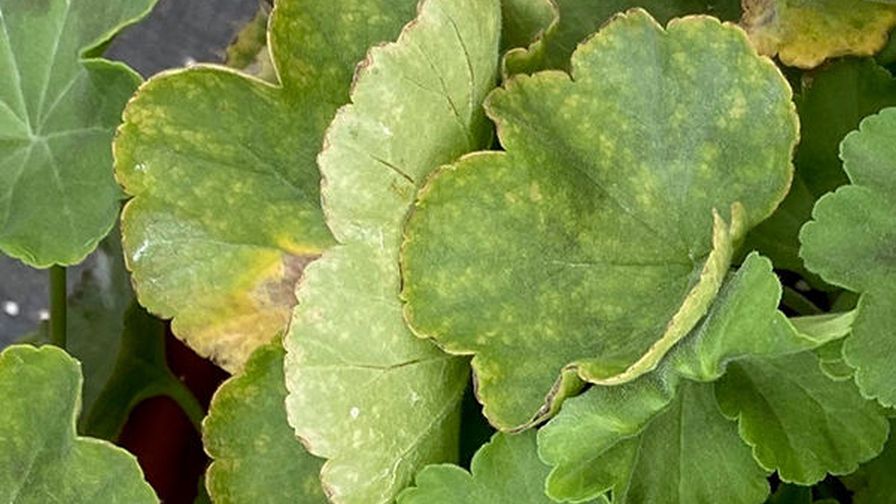A New Look At Biological Control: Can Plants Affect The Performance Of Natural Enemies?

Raymond Cloyd
Biological control is a plant protection strategy involving the release of natural enemies (biological control agents) such as parasitoids and predators to suppress or regulate insect and/or mite populations at levels that result in minimal noticeable plant damage. The success of a biological control program depends on a number of factors including quality of natural enemies, timing of release, release rates and environmental conditions (e.g., temperature and light intensity). However, what is typically not taken into consideration is how plants can affect the performance of natural enemies, including attack rate and searching ability.
Natural enemies, in general, may benefit plants by reducing the number of plant-feeding insects or mites (herbivores), and plants may subsequently help by increasing the susceptibility of herbivores to natural enemies. Furthermore, lower nutritional plant quality, based on nutritional content, may suppress or delay the growth and development of herbivores. This increases susceptibility to natural enemies over an extended period of time by prolonging feeding, which increases exposure to natural enemies. However, certain toxic compounds produced by plants such as alkaloids, cardiac glycosides, tomatine and other allelochemicals may be sequestered by herbivores for defensive purposes against natural enemies.
Plants Defend Themselves On Two Fronts
Plants produce two types of defenses: extrinsic and intrinsic. Extrinsic defenses are affiliated specifically with natural enemies by means of plants producing and then emitting volatile compounds (e.g., terpenoids) in order to attract natural enemies that will attack plant-feeding insects (and mites). Plants may respond to insect or mite feeding by releasing volatiles from damaged areas. These volatiles may help natural enemies in locating specific prey on areas of the plant. For example, lima bean (Phaseolus spp.) plants emit volatiles from leaves damaged by the two-spotted spider mite (Tetranychus urticae) in order to attract predatory mites. This makes it easier for the predatory mites to locate prey on the damaged plants instead of searching randomly.
These volatile compounds may also assist certain parasitoids with searching for small prey that are difficult to locate because they are well camouflaged (e.g., mealybugs or scales), or they are feeding on leaf undersides (e.g., whiteflies). Volatile compounds emitted from plant leaves in response to insect or mite damage allows parasitoids and even some predators to determine the difference between infested and non-infested plants, thus making it easier for natural enemies to locate prey. The concentration of volatiles emitted depends on plant type, herbivore species and environmental conditions including light intensity and day-length. Furthermore, cultural conditions such as water-stress may impact the release of volatiles from plant leaves.
Intrinsic defenses are exclusively produced by plants either chemically via toxins or digestibility, or physically by means of impediments, such as plant architecture, leaf toughness, cuticle thickness, leaf waxiness and trichomes (leaf hairs). Physical defenses may prolong the development time of larvae/nymphs, thus increasing exposure and susceptibility to natural enemies.
For example, tough leaves or thick cuticles may diminish the feeding rate and consequently prolong the developmental time of each larval or nymphal instar. This, in turn, increases exposure to natural enemies. However, some natural enemies, including ladybird beetle adults, may fall off of plants with leaves having waxy cuticles, which allows aphids to escape attack.

Reducing the number of leaf trichomes (leaf hairs) may increase the performance of Encarsia formosa.
Trichomes May Disrupt Performance Of Natural Enemies
Foliar pubescence, which is associated with trichomes or hairs on leaves, may negatively impact the performance of both parasitoids and predators by hindering movement or mobility, influencing walking speed and modifying walking patterns. This may be related to length, alignment and/or density of trichomes.
Trichomes may be angled downward, forming a physical barrier. They may be hooked to entangle natural enemies, or glandular, which entraps natural enemies by means of adhesive extractions. They may also be directly killed by contacting toxic fluids. Trichomes might affect the foraging behavior such as the searching ability or efficiency of parasitoids and predators and decrease their effectiveness in suppressing or regulating pest populations. Similar to a jungle, trichomes may impede the ability of certain natural enemies to locate prey on plants.
Leaves with a dense layer of trichomes make it more difficult for natural enemies to move around. Moreover, natural enemies may turn more frequently on leaves with many trichomes, leading to them searching on areas of the leaf that were already visited.
Trichome density may result in a decrease in encounter rate, which compromises the success of a biological control program. For example, larvae of the aphid predator Coleomegilla maculata, fall off cucumber (Cucumis sativus) leaves that contain many trichomes, which reduces the ability of the predator to find aphids on plants. Leaves of transvaal daisy (Gerbera jamesonii) and certain vegetable plants with a high trichome density have been reported to decrease the walking speed and predation rate of the predatory mites, Amblyseius swirskii, Neoseiulus cucumeris, and Phytoseiulus persimilis. This influences the ability of these predators’ to suppress or regulate pest populations. Honeydew, which is a clear, sticky substance excreted by phloem-feeding insect pests such as aphids, whiteflies, mealybugs and soft scales, may accumulate more on leaves with many trichomes than on smooth leaves (without trichomes). This can lead to parasitoids and even predators encountering droplets of honeydew, causing them to spend an exorbitant amount of time preening or grooming themselves. This results in natural enemies spending less time searching for prey.
Certain cucumber varieties may contain trichomes that interfere with the searching efficiency (and thus, parasitism rates) of the parasitoid, Encarsia formosa against the greenhouse whitefly (Trialeurodes vaporariorum). The parasitoid has difficulty finding and thus parasitizing greenhouse whitefly larvae on cucumber varieties with dense trichomes because the trichomes interfere with searching efficiency by means of affecting walking speed and pattern. Therefore, reducing the number of leaf trichomes may increase the performance of E. formosa. In fact, the parasitoid tends to walk faster on leaves with fewer trichomes and has a greater searching efficiency on cucumber varieties that do not contain trichomes compared to those with trichomes. Thus, E. formosa can parasitize more greenhouse whitefly larvae on cucumbers with fewer trichomes than cucumbers with a higher density
of trichomes.
Natural Defenses Can And Should Be Bred Into Plants
Recommendations have been made encouraging breeding programs to focus more on developing plant cultivars that allow natural enemies to be more effective. Plants with fewer trichomes may lead to an increase in the searching efficiency of certain parasitoids such as E. formosa. Trichomes on the leaves of transvaal daisy may impede the effectiveness of both E. formosa (for greenhouse whitefly) and the predatory mite, P. persimilis (for two-spotted spider mite). However, it should be noted that E. formosa may not be effective on smooth leaves (no trichomes) because they walk so fast; they do not notice greenhouse whitefly larvae, resulting in reduced parasitism rates. This decreases their ability to suppress or regulate whitefly populations, possibly leading to plant damage.
Glandular trichomes, associated with plants such as tomato (Lycopersicon lycopersicum), may entangle or entrap natural enemies in a sticky exudate, or the exudate may accumulate on their bodies and impair movement. This may also cause natural enemies to spend considerable time grooming themselves instead of searching for prey. Whitefly parasitoids such as Eretmocerus eremicus may become entrapped within the exudate of glandular trichomes of certain plant types, which inhibits their ability to locate prey, or they may be killed outright.
The glandular trichomes affiliated with the plant, Nicotiana glutinosa, have been reported to ensnare E. formosa. Potato (Solanum tuberosum) plants with an abundance of glandular trichomes are less susceptible (more resistant) to aphids; however, this negatively affects the natural enemies of aphids because they become entrapped in the exudates produced by the glandular trichomes.
The success of a biological control program is contingent on a number of factors including natural enemy quality, timing of releases, release rates and environmental conditions. However, it is also important to understand how plants may directly or indirectly impact the performance of natural enemies by means of physical impediments on leaves such as trichomes or hairs.










